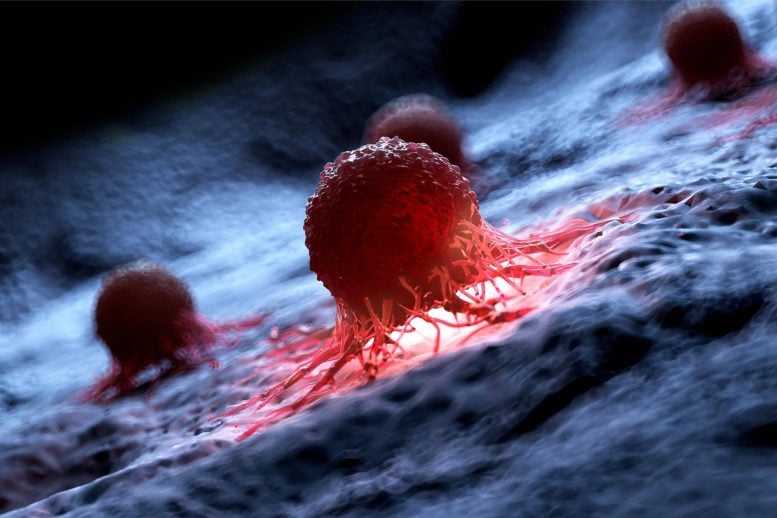The Legacy of a Late Scientist: Paving the Way for Life-Saving New Cancer Treatments

Recent studies have indicated that the SAS1B protein may be a potential target for new cancer treatments, particularly for solid tumors like breast, lung, and melanoma. This innovative research on SAS1B, initially studied in reproductive health, could possibly lead the way for antibody-based immunotherapies, providing new hope for patients diagnosed with hard-to-treat cancers.
The groundbreaking work of a departed scientist from the University of Virginia School of Medicine could potentially lead to revolutionary new treatments for solid cancer tumors, including breast cancer, lung cancer, and melanoma.
John Herr, PhD, was working with UVA Cancer Center’s Craig L. Slingluff Jr., MD, before his unexpected passing in 2016 to investigate whether a breakthrough from Herr’s lab could contribute to cancer treatment.
An eight-year research journey has validated this concept: Herr’s study into the SAS1B protein might lead to extensive and significant new treatments for multiple types of cancer, many of which are notoriously difficult to treat, reveals a new scientific paper in the Journal for ImmunoTherapy of Cancer published by Slingluff. Herr is mentioned as a senior author of the paper.
Slingluff, a surgical oncologist and translational immunologist at UVA Health and the UVA School of Medicine, expressed his delight at the research findings, reiterating John’s enthusiasm about the SAS1B protein being a valuable new target for human cancers.
Surprisingly, Herr’s lab was originally not focused on cancer. He was the head of UVA’s Center for Research in Contraceptive and Reproductive Health and during his tenure, he developed the first home fertility test for men, SpermCheck. Discoveries about the SAS1B protein found in developing eggs in women made by Herr might lead to new cancer immunotherapies.
It has been verified through Slingluff’s recent research that, although SAS1B is found in female reproductive cells called oocytes, it is also present on the surface of many different solid cancer cells. Interestingly, it did not appear on the surface of any other normal cells tested in Slingluff's laboratory. This provides an implication that the use of antibody-based immunotherapy may be developed to target the cancer cells while leaving healthy tissue unharmed.
Slingluff and his team concluded in their research paper that selectively targeting SAS1B could potentially result in a significant reduction in mortality from multiple types of cancer.
Slingluff also emphasized that immune therapy is revolutionizing cancer treatment, but certain cancers resist immune therapy due to the lack of suitable targets on those cancers. He expressed hope that Herr's research would bring new hope to patients with such cancers.
Finding ways to enhance cancer care is a fundamental mission of UVA Cancer Center. Similarly, advancing the field of immunotherapy is a critical mission of UVA’s forthcoming Paul and Diane Manning Institute of Biotechnology. The institute, currently under construction at Fontaine Research Park, is expected to expedite the development of new treatments and cures for a multitude of diseases, ultimately transforming healthcare delivery across Virginia and further afield.
Reference: “Cancer-oocyte SAS1B protein is expressed at the cell surface of multiple solid tumors and targeted with antibody-drug conjugates” by Arabinda Mandal, Jagathpala Shetty, Christine A Tran, Walter C Olson, Mriganka Mandal, Bhupal Ban, Eusebio S Pires, Sara J Adair, Todd W Bauer, Craig L Slingluff and John C Herr, 1 March 2024, Journal for ImmunoTherapy of Cancer. DOI: 10.1136/jitc-2023-008430
The research was supported by the Cancer Research Institute; the Grand Challenges Exploration Program from the Bill and Melinda Gates Foundation; the Wallace H. Coulter Translation Research Partnership Endowment; the Virginia Center for Innovative Technology; the National Cancer Institute, grants P30 CA044579 and T32 CA163177; and by the National Institutes of Health’s National Heart, Lung and Blood Institute, grant T32 HL007849.
UVA has filed patent applications on the use of SAS1B as a cancer drug and diagnostic target. Slingluff has received research support from Celldex, Glaxo-Smith Kline, Merck, 3M and Theraclion, and he receives licensing fees through the UVA Licensing and Ventures Group for patents for peptides used in cancer vaccines. A full list of the authors’ disclosures is included in the paper.




